01529 304273 - [email protected]
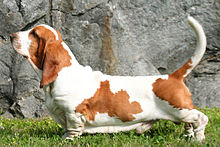 The Basset Hound is a short-legged hound. One of six recognized Basset Breeds in France, they are scent hounds, originally bred for the purpose of hunting rabbits and hare. Their sense of smell for tracking is second only to that of the Bloodhound.The name Basset is derived from the French word bas, meaning “low”, with the attenuating suffix -et, together meaning “rather low. The Basset Hound’s short stature is due to a genetic condition known as Osteochondrodysplasia (meaning abnormal growth of both bone and cartilage). Dwarfism in dogs is traditionally known as Achondroplasia. Basset Hounds, Dachshunds and Bulldogs are a few of the dog breeds classified as Achondroplastic.
The Basset Hound is a short-legged hound. One of six recognized Basset Breeds in France, they are scent hounds, originally bred for the purpose of hunting rabbits and hare. Their sense of smell for tracking is second only to that of the Bloodhound.The name Basset is derived from the French word bas, meaning “low”, with the attenuating suffix -et, together meaning “rather low. The Basset Hound’s short stature is due to a genetic condition known as Osteochondrodysplasia (meaning abnormal growth of both bone and cartilage). Dwarfism in dogs is traditionally known as Achondroplasia. Basset Hounds, Dachshunds and Bulldogs are a few of the dog breeds classified as Achondroplastic.
Their short stature can be deceiving; Bassets are surprisingly long and can reach things on table tops that other dogs of similar height cannot. Because Bassets are so heavy and have such short legs, they are not able to hold themselves above water for very long when swimming, and should always be closely supervised in the water.
Whippets have been called a “poor man’s racehorse.” As their heritage would suggest, whippets are outstanding running dogs and are top competitors insight hound events such as lure coursing, straight racing, and oval track racing. whippets are becoming successful obedience dogs. Many enjoy flyball and agility.
The Whippet is intelligent, lively, affectionate, sweet, and docile. This very devoted companion is quiet and calm in the home. The Whippet should never be roughly trained, for they are extremely sensitive both physically and mentally. Be sure to introduce plenty of variety when training them. The best results will be achieved by including games and running. They are good with children of all ages as long as the children do not roughhouse or tease the dog. Whippets are clean, virtually odour free, easy to care for and easy to travel with. They are good watchdogs but may be reserved with strangers. They will pursue and kill cats and other small animals if given the opportunity, but are good with other dogs. Household cats that they are raised with and have become accustom to will be left alone. They can be used to hunt. The Whippet’s sweet personality makes him a fine companion dog. The Whippet is the ultimate sprinter, unsurpassed by any other breed in its ability to accelerate to top speed and to twist and turn with matchless dexterity. Some can be difficult to housebreak while others housebreak quickly.
The Shetland Sheepdog or ‘Sheltie’ is loyal, willing and eager to please, making a wonderful companion dog. The breed is generally docile and alert with a pleasant temperament. Loving, loyal and affectionate with its family, this breed needs people. Socialize them well starting at puppyhood. They are good guard and watchdogs. Sensitive to the tone of your voice, they will not listen if they sense you do not mean what you say, or if you are too harsh. They are very intelligent, lively and trainable, as they are so intelligent they need to occupy their minds, they like to be kept busy. The Sheltie is above all an intelligent herder, and the instinct is still very strong in many of them, they love to chase things including cars. A Sheltie should not be allowed to run free near a road as it may decide to chase a car or something else it sees across the road, running a high risk of getting hit by a car. Because of its beauty and kindness, the Sheltie has become a popular companion dog.
They can become suspicious with strangers, especially with children. They may not allow themselves to be touched by strangers and will display noisy persistent barking, as they tell the humans to leave them alone. This can lead to guarding, snapping and even biting. They may hide behind something, barking persistently when company arrives. The dog needs to be told this is not an acceptable behaviour.
This breed is also known as ‘Chien de mantagne des Pyrenees, Great Pyrenees and the Patou. It is a large herd guarding breed.
ThePMD is a capable and imposing guardian, devoted to its family, and somewhat wary of strangers – human or canine. They are still often used to guard livestock. When not provoked, it is calm, well- mannered, and somewhat serious. Temperamentally it is courageous, very loyal and obedient and Gently affectionate with those he loves. The PMD is devoted to its family even if self-sacrifice is required.
It does best with children when it is raised with them from puppyhood, and if they are not being used as working flock guards it is important to socialize them well with people, place and noises. It has an independent nature, and may try to dominate a less secure or meek owner, and/or an owner who treats the dog as if he is human, becoming stubborn or territorial as it tries to fulfil the role of pack leader its owner is not performing. If left alone inside the home without the proper amount of exercise and or leadership they can become destructive. The PMD is good with non-canine animals, and usually loves cats. These dogs do not reach maturity until they are about 2 years old. Some are not good off the leash and may wander away. PMD’s tend to bark a lot and some tend to drool and slobber, so not the ideal choice for a city or suburban household. The PMD can be slow to learn new commands, slow to obey, and somewhat stubborn to train. For this reason the breed is ranked #64 (out of 69 breeds) in Stanley Coren’s The Intelligence of Dogs.
The PMD has proven to be a very versatile breed working as an avalanche rescue dog, as a cart-puller, sled dog, as a pack dog on ski trips, a flock guardian, dog of war, and as a companion and defender of family and property.
The Large Munsterlander is a tall multi-purpose gundog from Munster in Germany, first registered by the UK Kennel Club in 1971.
The breed is courageous, cheerful, intelligent and obedient, and makes a wonderful house companion dog and is very trainable. Munsterlanders are loyal and friendly dogs that are responsive to their humans. Although If the Munsterlander is lacking in leadership and or mental and physical exercise they can get destructive and bark when left alone in the house. They are not guard dogs and generally love everyone. The Munster does well in obedience, and is good with other animals and with children.
They like to retrieve, particularly from water and naturally like to carry things about in their mouths. They will be happiest when used as working dogs. Bred for training and ability to withstand the pressures involved, this dog will adapt to any terrain whether it be valleys, prairies, forest or water, and to every type of hunting. It is resistant to fatigue and to bad weather. Particularly appreciated for the sureness of its point and the precision with which it retrieves.
The Border Collie is a herding dog breed developed in the Anglo-Scottish border region for herding livestock, especially sheep. It is the most widespread of the collie breeds.
Typically extremely energetic, acrobatic, and athletic, they frequently compete with great success in dog sports, in addition to their success in sheepdog trials, and are often cited as the most intelligent of all dogs. In January 2011, a Border Collie named Chaser was reported to have learned 1,022 words ( see separate article).
The border collie is one of the hardest working dogs thriving on praise. Border Collies are represented among the leaders in competitive levels in various sports, excelling in agility skills, obedience, sheepdog trials and Frisbee (TM).
The Border Collie is highly energetic with great stamina. Provided they gets sufficient activity to keep them occupied and ample exercise, the Border Collie will get along quite happily with other dogs, and children, however they may be aggressive with other dogs of the same sex if you are not showing 100% leadership with them. They should not be trusted with small non-canine pets, however there are plenty of Border Collies that live and get along with family cats. This breed can be sensitive and should be very well socialized as a puppy to prevent shyness. To be truly happy, they need a lot of consistent leadership, extensive daily exercise, and a job to occupy their minds. Border Collies will often challenge their owners authority when they are adolescents. Dominance levels vary greatly even within the same litter.
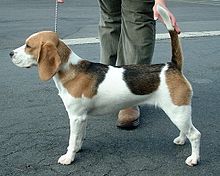 The Beagle is a small to medium-sized hound. It is similar in appearance to the Foxhound, but smaller, with shorter legs and longer, softer ears. Beagles are scent hounds, developed primarily for use on foot, tracking hare, rabbit, and other game. They have a great sense of smell and tracking instinct that sees them employed as detection dogs for prohibited agricultural imports and foodstuffs in quarantine around the world. Beagles are intelligent, and are popular as pets because of their size, even temper, happy to live in groups, and lack of inherited health problems. However these endearing characteristics also make them the dog of choice for animal testing.
The Beagle is a small to medium-sized hound. It is similar in appearance to the Foxhound, but smaller, with shorter legs and longer, softer ears. Beagles are scent hounds, developed primarily for use on foot, tracking hare, rabbit, and other game. They have a great sense of smell and tracking instinct that sees them employed as detection dogs for prohibited agricultural imports and foodstuffs in quarantine around the world. Beagles are intelligent, and are popular as pets because of their size, even temper, happy to live in groups, and lack of inherited health problems. However these endearing characteristics also make them the dog of choice for animal testing.
Beagles may exhibit a behaviour known as reverse sneezing, in which they sound as if they are choking or gasping for breath, but are actually drawing air in through the mouth and nose. The exact cause of this behaviour is not known, but it is not harmful to the dog.
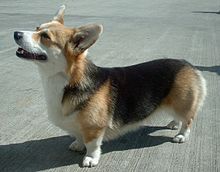 It must be said that life is never dull with a corgi, they are bold, spirited and energetic dogs, and are loyal companions, but do have a tendency to take over the home if you let them. The Pembroke Welsh Corgi is a herding dog breed, which originated in Pembrokeshire, Wales. It is one of two breeds known as Welsh Corgi: the other is the Cardigan Welsh Corgi. The most obvious difference between the Pembroke and the Cardigan is that the Pembroke lacks a tail while the Cardigan has a long tail. The Pembroke usually has straighter legs as it is not quite as long- bodied as a Cardigan; the Pembroke’s head is generally more wedge-shaped; the ears are smaller and closer together than the Cardigans; also the Pembroke tends to be lighter.
It must be said that life is never dull with a corgi, they are bold, spirited and energetic dogs, and are loyal companions, but do have a tendency to take over the home if you let them. The Pembroke Welsh Corgi is a herding dog breed, which originated in Pembrokeshire, Wales. It is one of two breeds known as Welsh Corgi: the other is the Cardigan Welsh Corgi. The most obvious difference between the Pembroke and the Cardigan is that the Pembroke lacks a tail while the Cardigan has a long tail. The Pembroke usually has straighter legs as it is not quite as long- bodied as a Cardigan; the Pembroke’s head is generally more wedge-shaped; the ears are smaller and closer together than the Cardigans; also the Pembroke tends to be lighter.
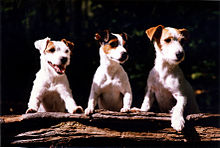 The Jack Russell terrier is a small terrier that has its origins in fox hunting. It’s usually a white-bodied dog and can have a variety of coat types, smooth, rough or broken-coated. Often any small white terrier is identified as a Jack Russell.
The Jack Russell terrier is a small terrier that has its origins in fox hunting. It’s usually a white-bodied dog and can have a variety of coat types, smooth, rough or broken-coated. Often any small white terrier is identified as a Jack Russell.
The Jack Russell is an energetic breed which relies on a high level of exercise and stimulation, and is relatively free from serious health complaints. It has gone through several changes over the years, through different use and breed standards set by kennel clubs. Recognition for the breed by kennel clubs has been opposed by the breed’s parent societies – which resulted in the breeding and recognition of the Parson Russell terrier.
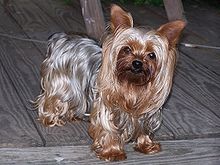 The Yorkshire Terrier is a small terrier type dog developed in the 19th century in the county of Yorkshire, England to catch rats in clothing mills. The defining features of the breed are its size, 3 pounds (1.4 kg) to 7 pounds (3.2 kg), and its silky blue and tan coat. The breed is nicknamed Yorkie and is placed in the Toy section by the kennel clubs, although all agree that the breed is a terrier. A popular companion dog, the Yorkshire Terrier has also been part of the development of other breeds, such as the Australian Silky Terrier.
The Yorkshire Terrier is a small terrier type dog developed in the 19th century in the county of Yorkshire, England to catch rats in clothing mills. The defining features of the breed are its size, 3 pounds (1.4 kg) to 7 pounds (3.2 kg), and its silky blue and tan coat. The breed is nicknamed Yorkie and is placed in the Toy section by the kennel clubs, although all agree that the breed is a terrier. A popular companion dog, the Yorkshire Terrier has also been part of the development of other breeds, such as the Australian Silky Terrier.
Yorkies seem oblivious of their small size. They are very eager for adventure. They are highly energetic, brave, loyal and clever. With owners who take the time to understand how to treat a small dog, the Yorkie is a wonderful companion! Affectionate with their master, but if humans are not this dog’s pack leader, they can become suspicious and aggressive to strangers both animal and human. They can also become yappy, as the dog does their best to tell you what THEY want YOU to do. They have a true terrier heritage and need someone who understands how to be their leader, otherise thet can develop Small Dog Syndrome. Yorkies who become demanding and dependant appearing to need a lot of human attention and/or developing jealous behaviours, snapping if surprised, frightened or over-teased or eve ndon’t get heir own way over food or sleeping places. Owners who do not instinctually meet the dogs needs can also find them to become over-protective, and even neurotic. The basic message is to remember that although small, a Yorkie is a dog, not a toy and needs the discipline that all dogs do in order to be a happy and contented member of your household.